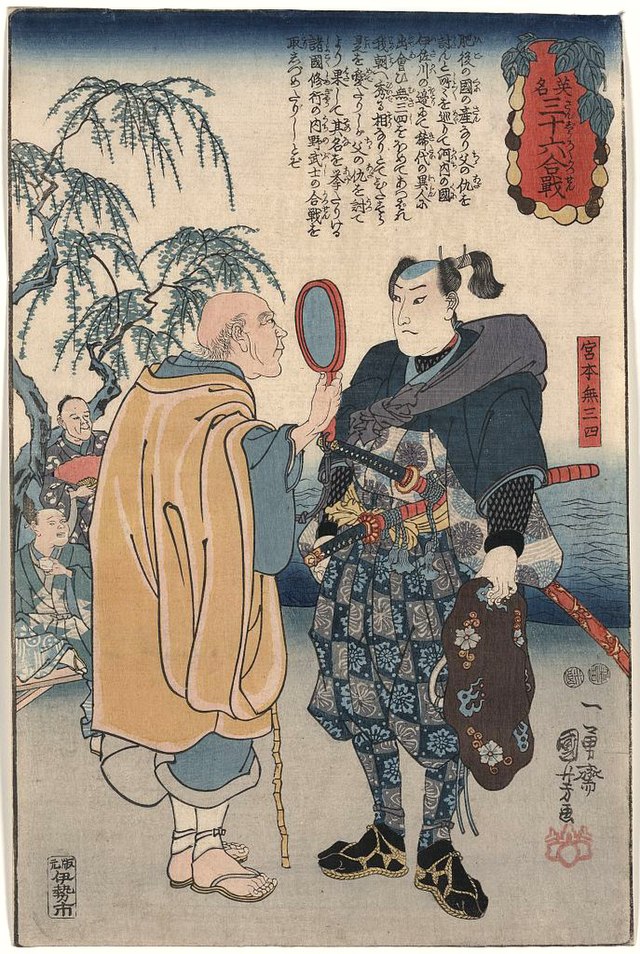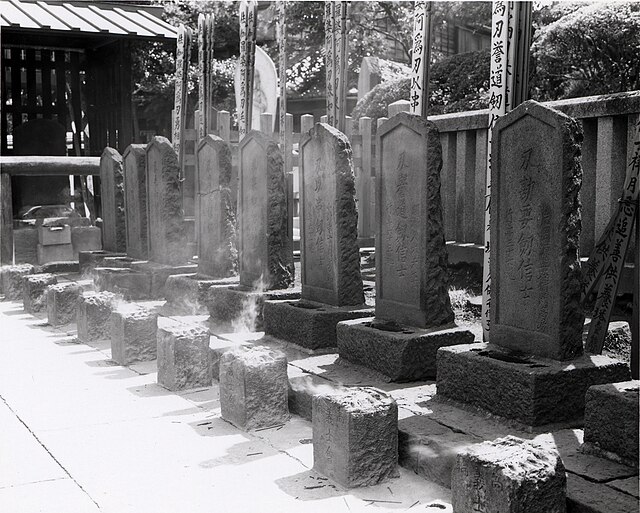Loading AI tools
Samurai without a lord or master From Wikipedia, the free encyclopedia
In feudal Japan (1185–1868), a rōnin (/ˈroʊnɪn/ ROH-nin; Japanese: 浪人, IPA: [ɾoːɲiɴ], 'drifter' or 'wandering man', lit. 'unrestrained or dissolute person') was a samurai who had no lord or master and in some cases, had also severed all links with his family or clan.[1] A samurai becomes a rōnin upon the death of his master, or after the loss of his master's favor or legal privilege.[2][3]
This article needs additional citations for verification. (January 2023) |


In modern Japanese, the term is usually used to describe a salaryman who is unemployed or a secondary school graduate who has not yet been admitted to university.[4][5]
The word rōnin is usually translated to 'drifter' or 'wanderer'; however, per kanji, rō (浪) means "wave" as on the water, as well as "unrestrained, dissolute", while nin (人) means "person". It is an idiomatic expression for 'vagrant' or 'wanderer', someone who does not belong to one place. The term originated in the Nara and Heian periods, when it referred to a serf who had fled or deserted his master's land. It later came to be used for a samurai who had no master. In medieval times, the ronin were depicted as the shadows of samurai, master-less and not honorable.
According to the Bushido Shoshinshu (the "Code of the Warrior"), a samurai was supposed to commit seppuku (also harakiri, "belly cutting", a form of ritual suicide) upon the loss of his master.[6][7] One who chose not to honor the code was "on his own" and was meant to suffer great shame. The undesirability of rōnin status was mainly a discrimination imposed by other samurai and by daimyō, the feudal lords.[citation needed]
Like other samurai, rōnin wore two swords.[8] Rōnin used a variety of other weapons as well. Some rōnin—usually those who lacked money—would carry a bō (staff around 1.5 to 1.8 m (5 to 6 ft)) or jō (smaller staff or walking stick around 0.9 to 1.5 m (3 to 5 ft)) or a yumi (bow). Most weapons would reflect the ryū (martial arts school) from which they came if they were students.[citation needed]
During the Edo period, with the shogunate's rigid class system and laws, the number of rōnin greatly increased; confiscation of fiefs during the rule of the third Tokugawa shōgun Iemitsu resulted in an especially large increase of their number.[2] During previous ages, samurai were able to move between masters and even between occupations. They could also marry between classes. However, during the Edo period, samurai were restricted, and were—above all—forbidden to become employed by another master without their previous master's permission.[citation needed]
Because the former samurai could not legally take up a new trade, or because of pride were loath to do so, many rōnin looked for other ways to make a living with their swords. Those rōnin who desired steady, legal employment became mercenaries that guarded trade caravans, or bodyguards for wealthy merchants. Many other rōnin became criminals, operating as bandits and highwaymen, or joining organized crime in towns and cities. Rōnin were known to operate or serve as hired muscle for gangs that ran gambling rings, brothels, protection rackets, and similar activities. Many were petty thieves and muggers. The criminal segment gave the rōnin of the Edo period a persistent reputation of disgrace, with an image of thugs, bullies, cutthroats, and wandering vagrants.[2] After the abolition of the Samurai, some of the ronin continued with their thuggery and their mercenary work and activities, such as participating in the infamous assassination of Korean Empress Myeongseong of the Joseon Dynasty in 1895, the Eulmi Incident.[citation needed]

Until the Sengoku period, peasants accounted for the majority of daimyō armies, so they accounted for the majority of ronin.[citation needed]
Especially in the Sengoku period, daimyō needed additional fighting men, and even if a master had perished, his rōnin was able to serve new lords. In contrast to the later Edo period, the bond between the lord and the vassal was loose, and some vassals who were dissatisfied with their treatment left their masters and sought new lords. Many warriors served a succession of masters, and some even became daimyō. As an example, Tōdō Takatora served ten lords. Additionally, the division of the population into classes had not yet taken place, so it was possible to change one's occupation from warrior to merchant or farmer, or the reverse. Saitō Dōsan was one merchant who rose through the warrior ranks to become a daimyō.[citation needed]
As Toyotomi Hideyoshi unified progressively more significant parts of the country, daimyō found it unnecessary to recruit new soldiers. The Battle of Sekigahara in 1600 resulted in the confiscation or reduction of the fiefs of large numbers of daimyō on the losing side; consequently, many samurai became rōnin. As many as a hundred thousand rōnin joined forces with Toyotomi Hideyori and fought at the Siege of Osaka. In the ensuing years of peace, there was less need to maintain expensive standing armies, and many surviving rōnin turned to farms or became townspeople. A few, such as Yamada Nagamasa, sought adventure overseas as mercenaries. Still, the majority lived in poverty as rōnin. Their number approached half a million under the third Tokugawa shōgun Iemitsu.[citation needed]
Initially, the shogunate viewed them as dangerous and banished them from the cities or restricted the quarters where they could live. They also prohibited serving new masters. As rōnin found fewer options, they joined in the Keian Uprising of 1651. This forced the shogunate to rethink its policy. It relaxed restrictions on daimyō inheritance, resulting in fewer confiscations of fiefs, and it permitted rōnin to join new masters.[citation needed]
Not having the status or power of employed samurai, rōnin were often disreputable and festive,[2] the group targeted humiliation or satire. It was undesirable to be a rōnin, as it meant being without a stipend or land. As an indication of the shame felt by samurai who became rōnin, Lord Redesdale recorded that a rōnin killed himself at the graves of the forty-seven rōnin. He left a note saying that he had tried to enter the service of the daimyō of Chōshū Domain but was refused. He killed himself, wanting to serve no other master and hating being a rōnin. On the other hand, the famous 18th-century writer Kyokutei Bakin renounced his allegiance to Matsudaira Nobunari, in whose service Bakin's samurai father had spent his life. Bakin voluntarily became a rōnin, and eventually spent his time writing books (many of them about samurai) and engaging in festivities.[citation needed]
In the 19th century, Emperor Meiji abolished the Samurai class and any status the ronin had died with them.[citation needed]

Numerous modern works of Japanese fiction set in the Edo period cast characters who are rōnin.[citation needed]
Seamless Wikipedia browsing. On steroids.
Every time you click a link to Wikipedia, Wiktionary or Wikiquote in your browser's search results, it will show the modern Wikiwand interface.
Wikiwand extension is a five stars, simple, with minimum permission required to keep your browsing private, safe and transparent.